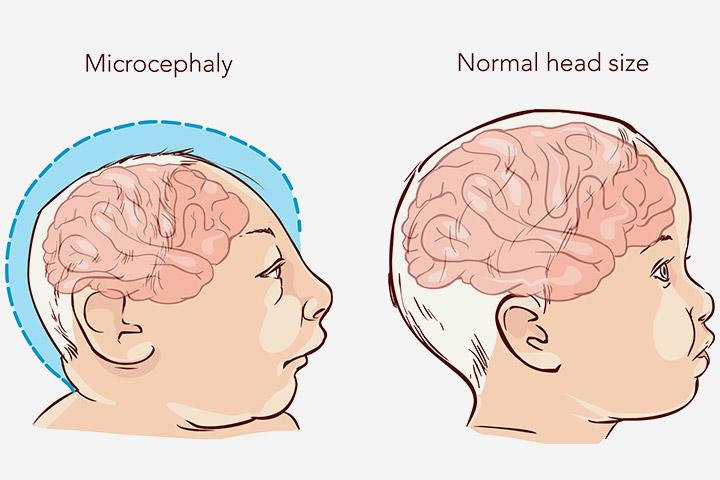Image: Shutterstock
Microcephaly is a neurodevelopmental disorder that causes significantly small head size in infants compared to other infants of the same gender and age. Most microcephaly cases happen due to abnormal brain development during fetal life or cessation of brain growth during infancy.
Smaller head size also means a smaller brain, which may not be developed enough to carry out its functions. Microcephaly may occur with other birth defects (congenital disabilities) or as an isolated problem.
Read this post to know about the symptoms, causes, risk factors, treatment, and prevention of microcephaly in infants.
Signs And Symptoms Of Microcephaly
Significantly smaller head size for the age is the primary sign of microcephaly in infants. Other signs and symptoms associated with microcephaly may include the following (1).
- Backward-sloping forehead
- Facial deformations
- Hyperactivity
- Speech delay
- Coordination and movement problems
- Seizures
- Poor feeding
- Abnormal muscle tones, such as hypertonia or hypotonia
- Growth and development issues
- Short stature (dwarfism)
- Vision and hearing impairment
- Joint deformations in microcephaly cases associated with Zika virus infection
A head size below the first percentile on a growth chart is diagnosed as microcephaly in infants, irrespective of the presence of other signs and symptoms.
You may seek pediatric consultation if you feel that your baby has a smaller head circumference or their head size is not growing during infancy.
Causes Of Microcephaly
Microcephaly can be congenital (present at birth) or develop during infancy. The following are the various genetic and environmental factors that may lead to microcephaly (2).
- Chromosomal abnormalities, such as Down syndrome, or certain metabolic disorders that affect the brain may cause microcephaly in infants.
- Craniosynostosis is the premature fusion of the sutures between skull bones. This may result in microcephaly and abnormal brain development.
- Prenatal infections, such as chickenpox (varicella), cytomegalovirus infection, toxoplasmosis, Zika virus infection, and rubella (German measles), may increase the risk of congenital microcephaly.
- Cerebral anoxia or decreased oxygen levels during fetal life may also negatively affect brain development. This can be due to pregnancy complications, such as placental insufficiency.
- Severe malnutrition during fetal life and infancy may affect brain development and increase the risk of microcephaly.
- Traumatic brain injuries during early infancy may cause microcephaly in some babies.
- Exposure to toxic substances, alcohol, smoke, and drugs may increase the risk of microcephaly and other brain anomalies.
- Unmanaged maternal phenylketonuria could be associated with microcephaly in babies.
Most babies tend to develop microcephaly due to prenatal or genetic reasons rather than factors or events during infancy.
Complications Of Microcephaly
Complications may depend on the severity and underlying causes of microcephaly. The following complications are commonly associated with microcephaly (3).
- Speech and movement delays and difficulties
- Facial deformations
- Dwarfism
- Intellectual disabilities
- Seizures
Some babies may have normal brain development and intelligence despite a head size smaller than the average head size for a baby of their age and gender.
Prevention Of Microcephaly
It may not be possible to prevent all microcephaly cases, such as microcephaly due to genetic factors. The following precautions may help prevent the risk of microcephaly in some babies.
- Good prenatal care may help reduce the risk of prenatal infections and other pregnancy complications.
- Cessation of drugs, alcohol, or smoking before planning a pregnancy may help avoid the risk of microcephaly in some babies.
- Maternal vaccinations and control of maternal diseases before and during pregnancy may also prevent certain risk factors.
- Avoiding mosquito bites during pregnancy may prevent congenital microcephaly and other neurological complications due to Zika virus infection.
- Genetic counseling and testing for parents with a child having microcephaly may help plan the second child.
- Early identification and treatment of issues in infants, such as malnutrition or craniosynostosis, may help avoid microcephaly.
Diagnosis Of Microcephaly
Congenital microcephaly can be identified during the late second-trimester ultrasound (2). Most cases are identified at the time of birth or during regular checkups. The baby’s head circumference is usually measured during each pediatric visit in the first year of life.
The head circumference is compared to other babies of the same age and gender on a standardized growth chart in percentiles. Babies with microcephaly fall below the first percentile on the growth chart.
If microcephaly is diagnosed, doctors may ask about family and prenatal health history to identify the possible causes.
Diagnostic tests, such as blood tests, MRI scans, or CT scans, are often ordered to identify the underlying cause.
Treatment For Microcephaly In Infants
There is no specific treatment to increase the head size or reverse the complications of most microcephaly cases. Surgical correction of craniosynostosis may help the brain grow and develop correctly. Surgeries are helpful if done in early infancy before the brain development is complete.
Pediatric neurologists may focus on the management of existing complications of microcephaly. The management techniques may include (4):
- Speech therapy
- Physiotherapy
- Occupational therapy
- Medications for hyperactivity and seizures
Babies with mild deviations in head size may not have any long-term effects and may not require specific management. Severe microcephaly needs interventions to manage the associated problems.
Microcephaly is a lifelong condition in most babies. There is no predicted life expectancy for microcephalic babies since the prognosis may vary based on severity and causes. Early diagnosis and interventions may help avoid any associated complications. Several management techniques could help significantly improve the child’s quality of life.

